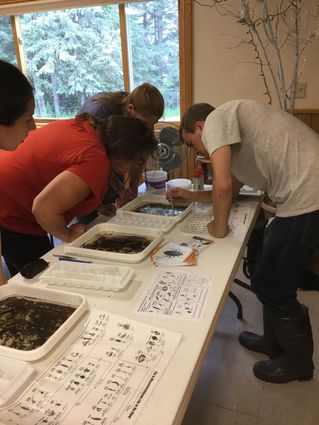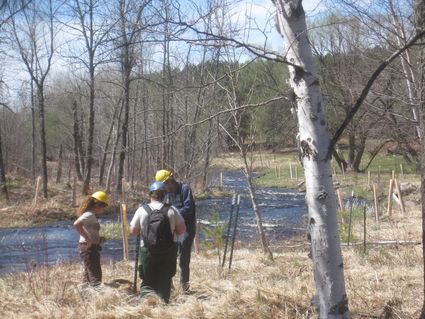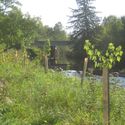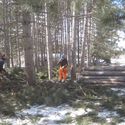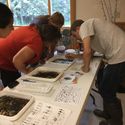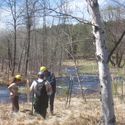Carlton district gets bang for its buck on conservation
July 19, 2019
ROI: Return on Investment. For those who don’t know, this simply means what you get (return) for what you give (invest). And as a taxpayer, you have the right and responsibility to ask about the returns (services given) for your investments (taxes).
Every year, the Carlton Soil and Water Conservation District SWCD publishes an annual report that tells taxpayers and Carlton County landowners what their ROI is for the federal, state, and local public funds that support SWCD programs, projects and staff. Using these funds, as well as awarded grants, Carlton SWCD works to fulfill its mission to “assist landowners in protecting and enhancing the natural resources of Carlton County.”
Many SWCD projects and programs have been presented to you through articles in the county’s newspapers. Here’s a behind-the-scenes look at the services the SWCD provides to county landowners.
“Carlton SWCD offers technical and financial assistance to landowners to help them design and pay for conservation practice implementation,” said Brad Matlack, Carlton SWCD manager.
Working with the Department of Agriculture Natural Resources Conservation Service, the SWCD brought planning services to landowners of 2,720 acres in Carlton County during 2018. Of this number, 728 acres were involved in implemented projects, ranging from installing culverts and controlling erosion, to maintaining dams and riparian buffers, to improving forest stands.
Although the designs that the SWCD develops for conservation projects aren’t always implemented right away, much of the planning work does result in implementation in future years. In fact, in 2018 alone Carlton SWCD directly funded $44,421 in projects with Carlton landowners, Matlack said, adding that the SWCD’s federal partners funded an additional $147,422 in projects, for a total of $191,843 in conservation projects implemented in the county.
Forestry
Consulting with forest landowners and creating Forest Stewardship Plans continues to be a key service of the Carlton SWCD and occupies much of the work forestry specialist Kelly Smith does. Smith also works with the Conservation Corps of Minnesota to assist landowners in the “tough and time-consuming job of helping young trees survive the first few years after planting,” he said.
Smith also works with the Kettle River Woodland Council. In 2018, he helped coordinate a Forestry Management Day for Timber and Wildlife as well as three Walk in the Woods events. These very successful events brought more than 125 forest landowners in contact with forestry professionals who assisted them in learning how to achieve their forest management goals.
In addition, through grant funds from the Lake Superior Coastal Program of the Minnesota Department of Natural Resources, landowners in the St. Louis River Watershed were contacted about their interest in planning and implementing forest riparian buffer conservation work. Because of the effects of slowly warming trout stream waters on brook trout and fisheries, forest riparian buffers have become even more important.
“A highly functioning forest riparian buffer provides critical conservation benefits to the streams,” Smith said, explaining that these buffers keep the water shaded, thus maintaining cool temperatures.
“They also hold shoreline in place with extensive root systems (thereby preventing erosions), slow flood waters, and provide habitat for insects that fish feed on,” Smith said.
As a result of SWCD contacts, about a third of the landowners indicated interest, including Fond du Lac Tribal Forestry and the Carlton County Land Department, and plans were developed for several projects which are goals for future grants. So far, Smith has worked with landowners to establish forest riparian buffers at five different sites involving 14.2 acres to improve and protect 2.3 miles of priority trout streams.
Watershed work
Besides riparian buffer work, there were several watershed projects and events in 2018. In fact, one major project started while another was completed, according to water quality specialist Melanie Bomier, who said the Nemadji Watershed was selected for a One Watershed One Plan (1W1P) planning grant in 2018.
“This grant will allow Carlton SWCD to begin transitioning from county-water planning to watershed-wide planning,” Bomier said. She admitted there will be challenges working across county lines, but Bomier is confident it will help better manage natural resources through prioritized, targeted and measurable implementation plans.
While the 1W1P was in its initial phases, the culvert inventory was being completed, thanks to an Enbridge “Ecofootprint” grant. The SWCD worked with the Carlton County Transportation Department to inventory culverts on all county-maintained roads, including evaluating the location and condition, as well as the biological and water quality impact of every culvert.
At the end of the project, 1,911 culverts were evaluated and 75 percent of them were found to be undersized. Many were also found to be in poor condition, perched, or showing erosion issues.
The culvert inventory was used after 2018 floods washed away many culverts in the southern part of the county. Pre-storm measurements from the inventory helped in replacing culverts to better match streams.
“Culverts that had been sized to the stream survived the flood with little damage and prevented waters from overtopping the road,” Bomier said. “This saved money in costly repairs and allowed county residents to continue using the roads after flooding.”
Educating landowners about watershed issues is also an important goal of the SWCD, and Bomier has been working with landowners and professionals in groups and projects in all four watersheds in Carlton County. In the Kettle River Watershed, landowners and residents, as well as resource professionals, participated in a bus tour of the watershed in June 2018. This tour, funded by a Minnesota Pollution Control Agency Civic Engagement grant, followed the Kettle and Moose Horn Rivers from their headwaters near Cromwell to where they join together in Pine County. Many important watershed topics were discussed at stops along the way, including forest resources, shoreline management, restoring streams, wild rice protection and culvert importance in stream connectivity.
In addition, the Elim Creek bioblitz in July 2018 brought together a group of dedicated volunteers to collect and identify macroinvertebrates (i.e., bugs) in Elim Creek in the Nemadji Watershed, Bomier said, explaining that a series of three dams were removed in 2014 and Elim Creek was restored to a flowing channel, and professionals wanted to learn how the stream was recovering through the bioblitz.
“Many bugs in the stream can tell us a lot about a stream’s health,” she shared, and “the bugs we found suggest the stream is currently in fair to good condition.”
Agriculture
Working with farmers is one of the foundations of SWCD work. Twelve new farms were added to the Minnesota Agricultural Water Quality Certification Program in northeast Minnesota during 2018, agricultural water quality specialist Ryan Clark said, adding that they were also busy with outreach and partnering with other SWCDs on farmer workshops on things like soil health, cover crops and prescribed grazing.
Great strides were also made in brushland habitat management and enhancement in 2018. Jacob Granfors, a joint technician for both Carlton and Aitkin SWCDs, works specifically on conservation easement and wildlife habitat projects, especially with sharp-tailed grouse.
Granfors noted that during 2018, habitat was enhanced through tree removal, prescribed fire, conservation grazing, brush mowing, and shearing, which will improve and maintain high-quality brushland habitat for sharp-tails and the bobolink, yellow rail, sharp-tailed sparrow, short-eared owl, sandhill crane, and northern harrier.
“In Carlton County there were 881 acres mowed across six projects,” Granfors said, adding that this will greatly improve open landscape habitats needed for these wildlife.
Mentoring
To top off the year, Carlton SWCD staff were pleased and excited to teach and mentor three apprentices and interns throughout the year. Eimy Quispe, from Connecticut, spent the summer of 2018 helping with the culvert inventory, stream surveys, water monitoring, and outreach events. Carlton’s Tyler was much appreciated as he worked to complete stream surveys, assisted with water quality and biological monitoring, and helped to manage and organize the summer’s data. Chris Gass, from St. Cloud and a University of Minnesota Duluth graduate, is an intern from an MPCA program in partnership with AmeriCorps. Gass, who will have served Carlton SWCD for 11 months when he leaves in September, has been invaluable in his efforts to expand engagement with city residents especially with respect to stormwater and urban forestry. He has also done great work in assessing road clearing practices, creating informational handouts, establishing an “Adopt a Drain” program, and assisting cities with tree management plans.
In addition, SWCD staff helped hundreds of youth explore the natural world and learn about the care of our natural resources. The annual Area III SWCD Envirothon held in May is an outdoor learning event for high school students, testing their knowledge of forestry, wildlife, water quality, soils, and environmental current events. The annual Arbor Day tree planting, also held in May, helps Carlton County fourth-graders learn about forests and how to plant trees. And the Stream Table, provided by the SWCD to area elementary schools, offers hands-on demonstrations about watersheds, streams, erosion, sediment control, and conservation.
Last but not least, Carlton SWCD honored the following for their conservation work in the county for 2018: Steve Risacher of Wright was recognized as Soil Health Conservationist; Bob Nelson, Cloquet, Urban Forestry Conservationist; Vicki and Terry Anderson, Cloquet, Pollinator Conservationists; and Alan Finifrock, Cloquet, Outstanding Conservationist. In addition, Finifrock was chosen as the 2018 Minnesota Tree Farmer of the year and was also one of eight finalists for Minnesota’s Outstanding Conservationist award. Smith, who has worked with Finifrock for many years, stated that “Alan promotes woodland management …. He leaves a conservation legacy” and shares appreciation for the forest with everyone he comes in contact with.
What Finifrock does is what the Carlton SWCD also aims to do: to share appreciation for our natural resources and help others to conserve, learn about, and protect these resources. We want to help everyone leave a conservation legacy! And this, as Paul Harvey said, is “the rest of the story.”
Kim Samuelson is Carlton SWCD’s elected supervisor for District 4. For more information about the Carlton SWCD Annual Report or for any assistance or information, contact the SWCD at 218-384-3891. You can also check them out on Facebook or on their website at http://www.carltonswcd.org.

